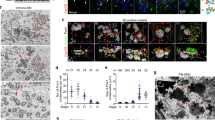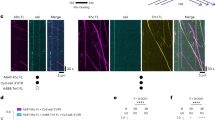Abstract
Drosophila melanogaster cellularization is a dramatic form of cytokinesis in which a membrane furrow simultaneously encapsulates thousands of cortical nuclei of the syncytial embryo to generate a polarized cell layer. Formation of this cleavage furrow depends on Golgi-based secretion and microtubules1,2,3. During cellularization, specific Golgi move along microtubules, first to sites of furrow formation and later to accumulate within the apical cytoplasm of the newly forming cells3. Here we show that Golgi movements and furrow formation depend on cytoplasmic dynein. Furthermore, we demonstrate that Lava lamp (Lva), a golgin protein that is required for cellularization, specifically associates with dynein, dynactin, cytoplasmic linker protein-190 (CLIP-190) and Golgi spectrin, and is required for the dynein-dependent targeting of the secretory machinery. The Lva domains that bind these microtubule-dependent motility factors inhibit Golgi movement and cellularization in a live embryo injection assay. Our results provide new evidence that golgins promote dynein-based motility of Golgi membranes.
This is a preview of subscription content, access via your institution
Access options
Subscribe to this journal
Receive 12 print issues and online access
$209.00 per year
only $17.42 per issue
Buy this article
- Purchase on Springer Link
- Instant access to full article PDF
Prices may be subject to local taxes which are calculated during checkout




Similar content being viewed by others
References
Foe, V. E., Odell, G. & Edgar, B. A. in The Development of Drosophila melanogaster (eds Bate, M. & Martinez Arias, A.) 149–300 (Cold Spring Harbor Laboratory Press, Plainview, NY, 1993).
Lecuit, T. & Wieschaus, E. Polarized insertion of new membrane from a cytoplasmic reservoir during cleavage of the Drosophila embryo. J. Cell Biol. 150, 849–860 (2000).
Sisson, J. C., Field, C., Ventura, R., Royou, A. & Sullivan, W. Lava lamp, a novel peripheral golgi protein, is required for Drosophila melanogaster cellularization. J. Cell Biol. 151, 905–918 (2000).
Vale, R. D. The molecular motor toolbox for intracellular transport. Cell 112, 467–480 (2003).
Vallee, R. B., Williams, J. C., Varma, D. & Barnhart, L. E. Dynein: An ancient motor protein involved in multiple modes of transport. J. Neurobiol. 58, 189–200 (2004).
Burkhardt, J. K. The role of microtubule-based motor proteins in maintaining the structure and function of the Golgi complex. Biochim. Biophys. Acta 1404, 113–126 (1998).
King, S. J. & Schroer, T. A. Dynactin increases the processivity of the cytoplasmic dynein motor. Nature Cell Biol. 2, 20–24 (2000).
Holleran, E. A. et al. βIII spectrin binds to the Arp1 subunit of dynactin. J. Biol. Chem. 276, 36598–36605 (2001).
Schroer, T. A. Dynactin. Annu. Rev. Cell Dev. Biol. 20, 759–779 (2004).
Kumar, S., Lee, I. H. & Plamann, M. Cytoplasmic dynein ATPase activity is regulated by dynactin-dependent phosphorylation. J. Biol. Chem. 275, 31798–31804 (2000).
Royou, A., Field, C., Sisson, J. C., Sullivan, W. & Karess, R. Reassessing the role and dynamics of nonmuscle myosin II during furrow formation in early Drosophila embryos. Mol. Biol. Cell 15, 838–850 (2004).
Mimori-Kiyosue, Y. & Tsukita, S. “Search-and-capture” of microtubules through plus-end-binding proteins (+TIPs). J. Biochem. (Tokyo) 134, 321–326 (2003).
Akhmanova, A. & Hoogenraad, C. C. Microtubule plus-end-tracking proteins: mechanisms and functions. Curr. Opin. Cell Biol. 17, 47–54 (2005).
Lantz, V. A. & Miller, K. G. A class VI unconventional myosin is associated with a homologue of a microtubule-binding protein, cytoplasmic linker protein-170, in neurons and at the posterior pole of Drosophila embryos. J. Cell Biol. 140, 897–910 (1998).
Pierre, P., Scheel, J., Rickard, J. E. & Kreis, T. E. CLIP-170 links endocytic vesicles to microtubules. Cell 70, 887–900 (1992).
Hoogenraad, C. C. et al. Mammalian Golgi-associated Bicaudal-D2 functions in the dynein-dynactin pathway by interacting with these complexes. EMBO J. 20, 4041–4054 (2001).
Short, B., Preisinger, C., Schaletzky, J., Kopajtich, R. & Barr, F. A. The Rab6 GTPase regulates recruitment of the dynactin complex to Golgi membranes. Curr. Biol. 12, 1792–1795 (2002).
Matanis, T. et al. Bicaudal-D regulates COPI-independent Golgi-ER transport by recruiting the dynein-dynactin motor complex. Nature Cell Biol. 4, 986–992 (2002).
Hoogenraad, C. C. et al. Bicaudal D induces selective dynein-mediated microtubule minus end-directed transport. EMBO J. 22, 6004–6015 (2003).
Turner, F. R. & Mahowald, A. P. Scanning electron microscopy of Drosophila embryogenesis. 1. The structure of the egg envelopes and the formation of the cellular blastoderm. Dev. Biol. 50, 95–108 (1976).
Fullilove, S. L. & Jacobson, A. G. Nuclear elongation and cytokinesis in Drosophila montana. Dev. Biol. 26, 560–577 (1971).
Robinson, J. T., Wojcik, E. J., Sanders, M. A., McGrail, M. & Hays, T. S. Cytoplasmic dynein is required for the nuclear attachment and migration of centrosomes during mitosis in Drosophila. J. Cell Biol. 146, 597–608 (1999).
McGrail, M. & Hays, T. S. The microtubule motor cytoplasmic dynein is required for spindle orientation during germline cell divisions and oocyte differentiation in Drosophila. Development 124, 2409–2419 (1997).
Waterman-Storer, C. M. & Holzbaur, E. L. The product of the Drosophila gene, Glued, is the functional homologue of the p150Glued component of the vertebrate dynactin complex. J. Biol. Chem. 271, 1153–1159 (1996).
Fan, S. S. & Ready, D. F. Glued participates in distinct microtubule-based activities in Drosophila eye development. Development 124, 1497–1507 (1997).
Suter, B. & Steward, R. Requirement for phosphorylation and localization of the Bicaudal-D protein in Drosophila oocyte differentiation. Cell 67, 917–926 (1991).
Field, C. M. & Alberts, B. M. Anillin, a contractile ring protein that cycles from the nucleus to the cell cortex. J. Cell Biol. 131, 165–178 (1995).
Byers, T. J., Dubreuil, R., Branton, D., Kiehart, D. P. & Goldstein, L. S. Drosophila spectrin. II. Conserved features of the α-subunit are revealed by analysis of cDNA clones and fusion proteins. J. Cell Biol. 105, 2103–2110 (1987).
Sharp, D. J. et al. Functional coordination of three mitotic motors in Drosophila embryos. Mol. Biol. Cell 11, 241–253 (2000).
Lansbergen, G. et al. Conformational changes in CLIP-170 regulate its binding to microtubules and dynactin localization. J. Cell Biol. 166, 1003–1014 (2004).
Acknowledgements
The authors thank B. Sullivan for his valued contributions during the early phase of this study, D. Branton, K. Miller, J. Scholey, C. Field, D. Ready, C. Field and B. Suter for their generous antibody gifts, A. Royou and R. Karess for the MyoII–GFP stock, A. De Lozanne, J. Fischer and W. Sullivan for their comments on the manuscript, S. Paige and L. Zhou for technical assistance, and the entire Sisson laboratory for contributions, both big and small. We sincerely apologize to those whose outstanding work was not cited due to referencing constraints. This study was supported by the National Institutes of Health grants GM067013 (J.C.S.) and GM053695 (T.S.H.), and The March of Dimes Basil O'Connor Award (J.C.S.).
Author information
Authors and Affiliations
Corresponding author
Ethics declarations
Competing interests
The authors declare no competing financial interests.
Supplementary information
Rights and permissions
About this article
Cite this article
Papoulas, O., Hays, T. & Sisson, J. The golgin Lava lamp mediates dynein-based Golgi movements during Drosophila cellularization. Nat Cell Biol 7, 612–618 (2005). https://doi.org/10.1038/ncb1264
Received:
Accepted:
Published:
Issue Date:
DOI: https://doi.org/10.1038/ncb1264
This article is cited by
-
Expression and functional analysis of cytoplasmic dynein during spermatogenesis in Portunus trituberculatus
Cell and Tissue Research (2021)
-
Reticular adhesions are a distinct class of cell-matrix adhesions that mediate attachment during mitosis
Nature Cell Biology (2018)
-
Gorab is a Golgi protein required for structure and duplication of Drosophila centrioles
Nature Genetics (2018)
-
Coupling fission and exit of RAB6 vesicles at Golgi hotspots through kinesin-myosin interactions
Nature Communications (2017)
-
Analysis of mitochondrial organization and function in the Drosophila blastoderm embryo
Scientific Reports (2017)



